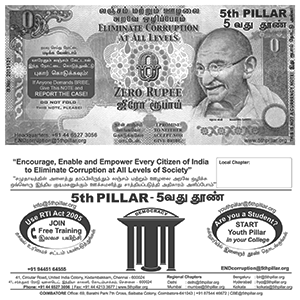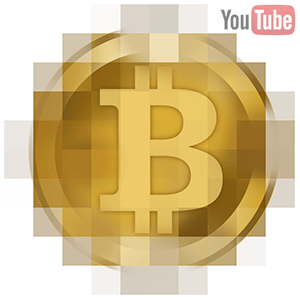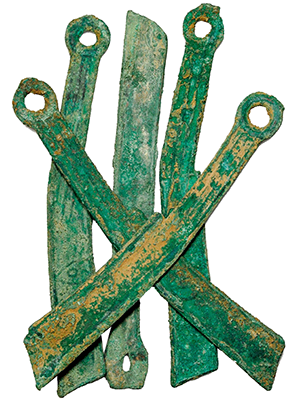Bored Ape Yacht Club (BAYC) is a non-fungible token (NFT) collection built on the Ethereum blockchain. The collection features profile pictures of cartoon apes that are procedurally generated by an algorithm.
The parent company of Bored Ape Yacht Club is Yuga Labs. The project launched in April 2021. Owners of a Bored Ape NFT are granted access to a private online club, exclusive in-person events, and intellectual property rights for the image.
read more »
Bored Ape
Dogecoin
Dogecoin [dowzh-coin] (Ð) is a cryptocurrency featuring a likeness of the Shiba Inu dog from the ‘Doge’ Internet meme as its logo. Introduced as a ‘joke currency’ in 2013, Dogecoin quickly developed its own online community and reached a capitalization of $60 million within months.
It’s market capitalization peaked in 2018 at $2b; today it is pegged at $600m. In July 2020 the price of Dogecoin spiked following a TikTok trend aiming to get the coin’s price to $1.
read more »
Zero Rupee Note
A zero-rupee note is a banknote imitation issued in India as a means of helping to fight systemic political corruption. The notes are ‘paid’ in protest by angry citizens to government functionaries who solicit bribes in return for services which are supposed to be free.
Zero rupee notes, which are made to resemble the regular 50 rupee banknote of India, are the creation of a non-governmental organization known as 5th Pillar which has, since their inception in 2007, distributed over 2.5 million notes as of 2014. The notes remain in current use and thousands of notes are distributed every month.
read more »
Dwolla
Dwolla is a United States-only e-commerce company that provides an online payment system and mobile payments network by the same name. The company was founded in 2008 with services based only in Iowa. After raising $1.31 million in funding, Dwolla launched nationally in 2009 with founders Ben Milne (CEO) and Shane Neuerburg (CTO), in Des Moines, Iowa, United States, with a few small banks and retailers. Transactions using Dwolla surpassed $1 million a week and its Iowa user-base was overtaken in 2011, with 20,000 users. The company began with two employees and has approximately 15 employees as of June 2011.
The main pull for Dwolla is its low transaction fees. From its onset, Dwolla charged 25 cents per transaction, less than its main rival Paypal, which for several years has charged 30 cents, plus 1.9-2.9% of each transaction. The name Dwolla is a conjunct of ‘dollar’ and ‘web.’ Dwolla is notable for its interest among users of Bitcoin, a digital currency. Some Bitcoin exchanges allow users to buy Bitcoins with dollars transferred to the exchange via Dwolla, and allow users to sell Bitcoins and have the proceeds transferred back to them using Dwolla. Although Dwolla representatives have said that they saw growth due to Bitcoin users, they do not offer any official endorsement of Bitcoins.
Fictional Currency
A fictional currency is some form of defined or alluded currency in works of fiction. The names of such units of currency are sometimes based on extant or historic currencies (e.g. ‘Altairian dollars’ or ‘Earth yen’) while others, such as ‘Kalganids’ in Asimov’s ‘Foundation’ series, may be wholly invented. A particularly common type, especially in science fiction, is electronically managed ‘credits.’ In some works of fiction, exchange media other than money are used. These are not currency as such, but rather nonstandard media of exchange used to avoid the difficulties of ensuring ‘double coincidence of wants’ in a barter system.
Authors have to take care when naming fictional currencies because of the associations between currency names and countries; recognizable names for currencies of the future may be used to imply how history has progressed, but would appear out of place in an entirely alien civilization. Historical fiction may need research. Writers need not explain the exact value of their fictional currencies or provide an exchange rate to modern money; they may rely on the intuitive grasp of their readers, for instance that one currency unit is probably of little value, but that millions of units will be worth a lot.
read more »
Bitcoin
Bitcoin is a digital currency created in 2009 by Satoshi Nakamoto. It is also the name of the open source software he designed that uses it, and the peer-to-peer network that it forms. Unlike most currencies, bitcoin does not rely on a central issuer, like a bank or government.Bitcoin uses a distributed database across a peer-to-peer computer network to record transactions, and uses cryptography to provide basic security functions, such as ensuring that bitcoins can only be spent once, and only by the person who owns them.
Bitcoin’s design allows for anonymous ownership and transfers of value. Bitcoins can be saved on a personal computer in the form of a wallet file or kept with a third party wallet service, and in either case Bitcoins can be sent over the Internet to anyone with a Bitcoin address. Bitcoin’s peer-to-peer topology and lack of central administration make it impossible for any government or other authority to change the value of bitcoins or induce inflation by producing more of them.
read more »
Amero
The North American Currency Union is a theoretical economic and monetary union of three North American countries: Canada, the United States and Mexico. The hypothetical currency for the union is most often referred to as the amero. Conspiracy theorists contend that the governments of the United States, Canada, and Mexico are already taking steps to implement such a currency, as part of a ‘North American Union (NAU).’
In 2007, rumors and conspiracy theories began circulating across the Internet regarding alleged United States Treasury-issued amero coins. The inspiration behind these rumors may have been the posting of images of medallions created by coin designer Daniel Carr. Carr, who designed the New York and Rhode Island 2001 statehood quarters, sells medals and tokens of his own design on his commercial website, ‘Designs Computed.’ Among his designs are a series of gold, silver and copper fantasy issues of amero coins ranging in denomination from one to one thousand.
Knife Money
Knife money refers to large, cast, bronze, knife-shaped coins produced by Ancient Chinese governments and kingdoms approximately 2500 years ago. They had holes on the end to be easily strapped onto belts or rings. Known as ‘jin cuo dao’ in Chinese, knife money circulated in China between 600 to 200 BCE during the Zhou dynasty. There are several stories that attempt to explain how knife money was introduced but it is not certain if any or all are true.
In one story a prince who was running low on money to pay his troops allowed them to use their knives as a form of currency to barter with villagers and the medium became so popular that it became generally accepted. In another story, the same prince began accepting knives as payment for small fines in the place of the current legal ring currency. Knife money may also have been brought in by sea traders from the Indian Ocean. Over time, the currency slowly shrank until only the ring of the handle was produced as a symbol of the knife that it represented.
Polymer Banknote
Polymer banknotes were developed by the Reserve Bank of Australia, Commonwealth Scientific and Industrial Research Organization, and The University of Melbourne and were first issued as currency in Australia in 1988. These banknotes are made from the polymer biaxially-oriented polypropylene which greatly enhances durability. They also incorporate many security features not available to paper banknotes, making counterfeiting much more difficult. As of 2010, eight countries have converted fully to polymer banknotes: Australia, Bermuda, Brunei, New Zealand, Nicaragua, Papua New Guinea, Romania, and Vietnam.
An alternative polymer of polyethylene fibres marketed as Tyvek by DuPont was developed for use as currency by the American Bank Note Company in the early 1980s. Tyvek did not perform well in trials; smudging of ink and fragility were reported as problems. Only Costa Rica and Haiti issued Tyvek banknotes. Additionally, English printers Bradbury Wilkinson produced a version on Tyvek but marketed as Bradvek for the Isle of Man in 1983; however, they are no longer produced and have become collectors’ items.
Time Banking
Time Banking refers to an economic system that uses units of time as currency. A Time Bank, also known as a Service Exchange, is a community which practices time banking. The unit of currency, always valued at an hour’s worth of any person’s labor, used by these groups has various names, but is generally known as a Time Dollar in the U.S. and a Time Credit in the U.K. Time Banking is primarily used to provide incentives and rewards for work such as mentoring children, caring for the elderly, being neighborly—work usually done on a volunteer basis—which a pure market system devalues.
Essentially, the ‘time’ one spends providing these types of community services earns ‘time’ that one can spend to receive services. Time Banking had its intellectual genesis in the U.S. in the early 1980s. Today, 26 countries have active Time Banks. There are 108 Time Banks active in the U.K. and 53 officially recognized Time Banks in the U.S.
Terra
Terra (The Trade Reference Currency, TRC) is the name of a theorized ‘world currency.’ The concept is currently proposed by Belgian economist Bernard A. Lietaer and is designed to resist currency inflation. The currency is meant to be based on a basket of the 9-12 most important commodities (according to their importance in world wide trade). For example: 100 Terra = 1 barrel of oil + 10 bushels of wheat + 20 kg of copper, etc. The basic principle emerged from early concepts presented in an article in the French newspaper ‘Le Fédériste’ in 1933.
Liberty Dollar
The Liberty Dollar (ALD) was a private currency produced in the United States from 1998 – 2009. The currency was available in coins, gold and silver certificates, and as an electronic currency (eLD). ALD certificates are warehouse receipts for real gold and silver formerly owned by ALD certificate holders. The metal was warehoused at Sunshine Minting in Coeur d’Alene, Idaho prior to a November 2007 raid by the Federal Bureau of Investigation (FBI) and the Secret Service.
Until July 2009, the Liberty Dollar was distributed by Liberty Services (formerly known as NORFED), based in Evansville, Indiana. It was created by Bernard von NotHaus, the co-founder of the Royal Hawaiian Mint Company. In May 2009, von NotHaus and others were charged with federal crimes in connection with the Liberty Dollar and, on July 31, 2009, von NotHaus announced that he had closed the Liberty Dollar operation, pending resolution of the criminal charges.














